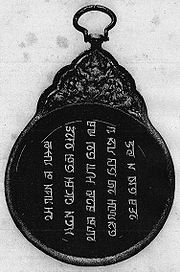
Paiza
Encyclopedia
Paiza or Gerege is a tablet of authority for the Mongol officials and envoys. This enabled the Mongol nobles and officials to demand goods and services from civilian populations.
 Although, only someone with paiza was allowed to supply with remounts and served specified rations, those carrying military rarities used the yam (route)
Although, only someone with paiza was allowed to supply with remounts and served specified rations, those carrying military rarities used the yam (route)
even without a paiza. The officials and nobles of the Mongol Empire
issued paizas unofficially and abused civils. Therefore, Ögedei Khan
(r. 1229–1241) prohibited the nobility
from issuing paizas and jarliqs.
To attract foreign or overseas merchants and talents, the Great Khans gave them paiza exempting taxes and allowed to use relay stations. However, Mongke Khan
(r. 1251–1259) limited notorious abuses and sent imperial investigators to supervise the business of the merchants who were sponsored by the Mongols. He prohibited them from using the imperial relay stations or yam (zam) and paizas.
Marco Polo
who visited the Yuan Dynasty
during the reign of Kublai Khan
(r. 1260–1294) left a good description of paiza.
The Ilkhan Ghazan (r. 1295–1304) reformed the issuance of jarliqs, creating set forms and graded seals, ordering that all jarliqs be kept on file at court and canceling jarliqs older than 30 years and old paizas. He fashioned new paizas into two ranks, contained the names of the bearers on them to prevent them from being transferred and were to be turned in at the end of the official’s term.

Yam (route)
Yam is a supply point route messenger system employed and extensively used and expanded by Genghis Khan and used by subsequent Great Khans and Khans.Relay stations were used to give food, shelter and spare horses for Mongol armies messengers...
even without a paiza. The officials and nobles of the Mongol Empire
Mongol Empire
The Mongol Empire , initially named as Greater Mongol State was a great empire during the 13th and 14th centuries...
issued paizas unofficially and abused civils. Therefore, Ögedei Khan
Ögedei Khan
Ögedei Khan, born Ögedei was the third son of Genghis Khan and second Great Khan of the Mongol Empire by succeeding his father...
(r. 1229–1241) prohibited the nobility
Nobility
Nobility is a social class which possesses more acknowledged privileges or eminence than members of most other classes in a society, membership therein typically being hereditary. The privileges associated with nobility may constitute substantial advantages over or relative to non-nobles, or may be...
from issuing paizas and jarliqs.
To attract foreign or overseas merchants and talents, the Great Khans gave them paiza exempting taxes and allowed to use relay stations. However, Mongke Khan
Möngke Khan
Möngke Khan , born Möngke, , was the fourth Great Khan of the Mongol Empire from July 1, 1251 – August 11, 1259. He was the first Great Khan from the Toluid line, and made significant reforms to improve the administration of the Empire during his reign...
(r. 1251–1259) limited notorious abuses and sent imperial investigators to supervise the business of the merchants who were sponsored by the Mongols. He prohibited them from using the imperial relay stations or yam (zam) and paizas.
Marco Polo
Marco Polo
Marco Polo was a Venetian merchant traveler from the Venetian Republic whose travels are recorded in Il Milione, a book which did much to introduce Europeans to Central Asia and China. He learned about trading whilst his father and uncle, Niccolò and Maffeo, travelled through Asia and apparently...
who visited the Yuan Dynasty
Yuan Dynasty
The Yuan Dynasty , or Great Yuan Empire was a ruling dynasty founded by the Mongol leader Kublai Khan, who ruled most of present-day China, all of modern Mongolia and its surrounding areas, lasting officially from 1271 to 1368. It is considered both as a division of the Mongol Empire and as an...
during the reign of Kublai Khan
Kublai Khan
Kublai Khan , born Kublai and also known by the temple name Shizu , was the fifth Great Khan of the Mongol Empire from 1260 to 1294 and the founder of the Yuan Dynasty in China...
(r. 1260–1294) left a good description of paiza.
The Ilkhan Ghazan (r. 1295–1304) reformed the issuance of jarliqs, creating set forms and graded seals, ordering that all jarliqs be kept on file at court and canceling jarliqs older than 30 years and old paizas. He fashioned new paizas into two ranks, contained the names of the bearers on them to prevent them from being transferred and were to be turned in at the end of the official’s term.

